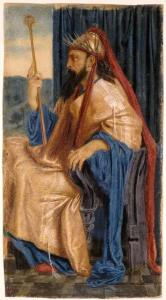King Solomon is traditionally (and I think, solidly) believed to have been king of the United Monarchy of Judah, from c. 970 – c. 931 B.C. We don’t have much at all to establish his existence and influence on history on grounds other than the historically trustworthy Hebrew Bible. I’ve written one article myself, along these lines: Archaeology & Solomon’s Temple-Period Ivory [1-28-23].
I would like to explore the question of Solomon’s legendary “mines” and offer a proposal. Where are they? How did he (or rather, those he sent) get there? And how do we connect them to Solomon’s era and reign? Let’s go on the journey of discovery together. I’m learning this as I write, and I’m happy, as always, to pass on my exciting finds to you.
The “clue” we have in the Bible with regard to Solomon’s “mines” is Tarshish:
1 Kings 9:11 (RSV) and Hiram king of Tyre had supplied Solomon with cedar and cypress timber and gold, as much as he desired, . . .
1 Kings 10:22 For the king had a fleet of ships of Tarshish at sea with the fleet of Hiram. Once every three years the fleet of ships of Tarshish used to come bringing gold, silver, ivory, apes, and peacocks.
2 Chronicles 9:21 For the king’s ships went to Tarshish with the servants of Huram; once every three years the ships of Tarshish used to come bringing gold, silver, ivory, apes, and peacocks.
Isaiah 60:9 For the coastlands shall wait for me, the ships of Tarshish first, to bring your sons from far, their silver and gold with them, . . .
Jeremiah 10:9 Beaten silver is brought from Tarshish, . . .
Ezekiel 27:12, 15 “Tarshish trafficked with you because of your great wealth of every kind; silver, iron, tin, and lead they exchanged for your wares. . . . The men of Rhodes traded with you; many coastlands were your own special markets, they brought you in payment ivory tusks and ebony.” (referring to Tyre: 27:2-3)
Not long afterwards, we read:
2 Chronicles 20:35-36 After this Jehoshaphat king of Judah joined with Ahaziah king of Israel, who did wickedly. He joined him in building ships to go to Tarshish, and they built the ships in Ezion-geber.
Jehoshaphat reigned from c. 873 to c. 849 B.C., and Ahaziah, somewhere between c. 853 and c. 849 B.C., so their reigns overlapped to some extent. Ahaziah reigned for just “two years”: according to 1 Kings 22:51. Assuming the general correctness of these dates, we know that ships were still being built to travel to Tarshish, about 80 years after Solomon’s death: presumably for the same trade goods. According to the Encyclopedia Britannica article, “Ezion-geber,” that town was “almost certainly founded about 950 BC by Solomon.” It was located at the northern end of the Gulf of Aqaba in what is now Jordan.
The other big “clue” we get from the Bible, is that Solomon was allies (and apparently very friendly) with Hiram, the Phoenician king of Tyre (r. 969–936 B.C.), and that Solomon’s “fleet of ships” were “at sea with the fleet of Hiram” (1 Kings 10:22 above). The Phoenicians were, as most fairly educated people are aware, the great seafarers of the ancient world. They lived on the Mediterranean coast (including in Tyre and Sidon), just north of modern Israel, in what is now Lebanon. They never lacked wood to build their ships, since they lived in close proximity to the famous cedars of Lebanon. Mark Cartwright, in his article, “The Phoenicians – Master Mariners” (World History Encyclopedia, April 28, 2016), described their sea journeys:
Hemmed in by mountains, then, when the time came, perhaps from the 12th century BCE, the natural direction of Phoenician expansion was not inland but the sea. As a result of this search for new resources such as gold and tin, the Phoenicians became accomplished sailors, creating an unprecedented trade network which went from Cyprus, Rhodes, the Aegean islands, Egypt, Sicily, Malta, Sardinia, central Italy, France, North Africa, Ibiza, Spain and beyond even the Pillars of Hercules and the bounds of the Mediterranean. In time, this network transformed into an empire of colonies so that the Phoenicians criss-crossed the seas and gained the confidence to reach such far-flung places as ancient Britain and the Atlantic coast of Africa.
Josephine Quinn, author of In Search of the Phoenicians (Princeton University Press, 2019), states:
Refining the arts of shipbuilding and navigation, they picked up the old ‘Route of the Islands’ that had led their Cypriot neighbours to Crete and Sicily and on to Sardinia, and they ventured further. Phoenician ships reached Iberia [Spain] and then looped around to return east with the winds and currents along the coast of the Maghreb. They visited new lands rich in metals, made new friends, and by about 900 BCE they had battled their way through the ‘Pillars of Hercules’—the Rock of Gibraltar and Jebel Musa—and out into the Atlantic Ocean. (“All at sea: The maritime lives of the ancient Phoenicians,” June 23, 2020)
1 Kings 10:14-23 Now the weight of gold that came to Solomon in one year was six hundred and sixty-six talents of gold, [15] besides that which came from the traders and from the traffic of the merchants, and from all the kings of Arabia and from the governors of the land. [16] King Solomon made two hundred large shields of beaten gold; six hundred shekels of gold went into each shield. [17] And he made three hundred shields of beaten gold; three minas of gold went into each shield; and the king put them in the House of the Forest of Lebanon. [18] The king also made a great ivory throne, and overlaid it with the finest gold. [19] The throne had six steps, and at the back of the throne was a calf’s head, and on each side of the seat were arm rests and two lions standing beside the arm rests, [20] while twelve lions stood there, one on each end of a step on the six steps. The like of it was never made in any kingdom. [21] All King Solomon’s drinking vessels were of gold, and all the vessels of the House of the Forest of Lebanon were of pure gold; none were of silver, it was not considered as anything in the days of Solomon. [22] For the king had a fleet of ships of Tarshish at sea with the fleet of Hiram. Once every three years the fleet of ships of Tarshish used to come bringing gold, silver, ivory, apes, and peacocks. [23] Thus King Solomon excelled all the kings of the earth in riches and in wisdom.
A talent in this period weighed about 66 pounds. Thus, the text informs us that Solomon obtained about 22 tons of gold in one year’s time. Note how verse 22 specifically says that the main source of all this gold, ivory, and silver was Tarshish. Therefore, it’s a reasonable, plausible assumption to conclude that this is where his “mines” were located. The question then becomes: where was Tarshish? Encyclopedia Britannica (“Tartessus”) renders its opinion:
ancient region and town of the Guadalquivir River valley in southwestern Spain, probably identical with the Tarshish mentioned in the Bible. It prospered from trade with the Phoenicians and Carthaginians but was probably destroyed by the latter about 500 BC. The exact site of the town is not known, but archaeological evidence suggests it may have been near present-day Sevilla (Seville).
An hour’s drive northwest of Seville takes one to Minas de Rio Tinto. An article in The Telegraph (“Discover Minas de Rio Tinto on a day trip from Seville,” Mary-Ann Ochota, February 20, 2015) explains:
Rio Tinto, which translates as the Red River, is the greatest known ancient mining complex in the world. These hillsides, part of a natural belt of exposed minerals that stretches across Portugal and Spain, have been plundered for their precious metal ores for more than 5,000 years.
The article references the mine’s “copper and silver” and the fact that “Roman miners extracted more than two million tons of silver-rich ore.” We’ve already determined that Phoenician ships visited Spain as far back as Solomon’s time, and that Solomon’s ships traveled with Phoenician ones to Tarshish. The pieces of the puzzle are rapidly coming together.
Gonzalo Garcia Garcia stated in his article, “The Rio Tinto mines, Huelva, Spain” (The Mineralogical Record, Vol. 27, Issue 4, July-August 1996): “The mines show evidence of extraction activities as early as the Phoenician period, where archeological records show recovery of gold, silver and copper.” Another article on the same mine (“An Ancient Mine with Links to the Search for Life on Mars: Rio Tinto Reopens,” Alicia McDermott, updated July 21, 2015, Ancient Origins) adds additional relevant information:
The Rio Tinto mine is named after the river it is located on in Huelva, Andalucía, Spain. Archaeologists have found artifacts in the area which suggest that Rio Tinto has been exploited for mining since the Chalcolithic or Copper Age (Early Bronze Age) 3000 BC. . . . As Rio Tinto is part of the Iberian Pyrite Belt, the area has been found to be rich in copper, tin and lead in large quantities, silver and gold in plenty, and even iron to a lesser extent.
It has now been verified from extrabiblical sources that all five minerals mentioned in the Bible as deriving from Tarshish (gold, silver, iron, tin, and lead) have been mined at Minas de Rio Tinto since very ancient times (starting long before Solomon was born). Everything fits the biblical description. Greek historian Herodotus (c. 484 – c. 425 B.C.) thought this area was the biblical Tarshish (iv. 152). The New Bible Dictionary (ed. J.D. Douglas, Grand Rapids, Michigan: Eerdmans, 1962, “Tarshish,” p. 1239) produced additional evidence: “[In] Sardinia . . . monumental inscriptions erected by the Phoenicians in the 9th century BC bear the name Tarshish.”
The Cyclopedia of Biblical, Theological, and Ecclesiastical Literature (James Strong and John McClintock; Harper and Brothers; New York, 1880, “Tarshish”) provides a fascinating overview:
Most interpreters, . . . are agreed that . . . the allusion is to Tartessus in Spain. . . .
As to the exact spot where Tartessis (so written originally) lay, authorities are not agreed, as the city had ceased to exist when geography began to receive attention; but it was not far from the Straits of Gibraltar, and near the mouth of the Guadalquivir, consequently at no great distance from the famous Granada of later days. . . .
[A]ll the articles reported in Jeremiah and Ezekiel to have been brought from Tarshish might have come from South-western Spain. Here there were mines of gold and silver, and Tartessus is expressly named as affording the latter mineral (Strabo, 3, 157; Diod. Sic.5, 35). Tin was brought by the Phoenicians from Britain into Spain, and thence carried to the Oriental markets. According to Diodorus Siculus (5, 38), tin was procured in Spain also, as well as lead, according to Pliny (Hist. Nat. 3, 4). Pliny’s words are forcible: “Nearly all Spain abounds in the metals-lead, iron, copper, silver, gold.” . . .
In the absence of positive proof, we may acquiesce in the statement of Strabo (3, 148) that the river Betis (now the Guadalquivir) was formerly called Tartessus, that the city Tartessus was situated between the two arms by which the river flowed into the sea, and that the adjoining country was called Tartessus.
British maritime archaeologist Dr. Sean Kingsley has pursued this line of reasoning even further:
Kingsley has spent the past three decades exploring over 350 shipwrecks. . . .
Kingsley further argues that an isotope analysis revealed that silver hoards discovered in the Holy Land were of Spanish origin. In addition, pottery discovered nearby in the Spanish city of Huelva, reportedly shows a connection to the Land of Israel and Phoenicia. According to Kingsley, Huelva is likely the biblical capital of Tarshish, a place of precious metals for King Solomon. . . . Recent discoveries of shekel weights, Near Eastern pottery and elephant tusks in Huelva, further links the site to the ancient Israelites and Phoenicians. (Michael Ireland, “Has British archaeologist found King Solomon’s maritime empire?,” Assist News, May 3, 2021)
Dr. Kingsley noted other evidences of this theory in an interview (with which I shall conclude):
When I started digging around, I found that Near Eastern or Phoenician remains are really very prevalent all the way from Huelva [southern Spain] in the west to Alicante in the east, which is an arc of some 690 kilometers [430 miles]. . . . Rio Tinto is 65 kilometers [40 miles] upriver from Huelva in Spain, which is situated on the coast of the Mediterranean. Rio Tinto was the biggest mine in antiquity and most famous in the Roman period. It is still being mined today. There is a little museum there with some Phoenician pottery. . . .
The discoveries at Huelva take you back 100 years earlier than those found at Rio Tinto [dated to 820 B.C.]. Now we are much closer to the time of King Solomon. . . .
Rio Tinto and Huelva are linked by a river, the Coloured River. And Huelva is on the coast and is a port city. And then the international shipping trade port was Cadiz [about 60 miles south]. So you have three hubs.
When they started excavating at Huelva, they found massive furnaces and sandstone molds for processing silver. And again lots of Phoenician pottery—40 percent of the pottery there was Near Eastern, or Phoenician. And next to it, the kind of goods we know the Near East specialized in. There was both ivory, raw and finished products. They also found murex shells—the royal purple, which is very much associated with the Bible—and which the Phoenicians were expert in processing. Parts of shipbuilding turned up—mortise and tenons used in making ships. And finally the date: at least 900 b.c.e. And according to this chronology, perhaps as early as 930 b.c.e., which overlaps precisely with the end of King Solomon’s reign. (Armstrong Institute Staff, “Evidence of King Solomon Found—in Spain! An Interview With Sean Kingsley,” Armstrong Institute of Biblical Archaeology, May 20, 2022)
***
Photo credit: King Solomon (1875), by Simeon Solomon (1840-1905) [public domain / picryl]
***
Summary: I survey the surprisingly strong archaeological & historical evidence regarding Solomon’s “mines” and the exact location of the legendary (but very real) Tarshish.














